
The S60 Platform was a software platform for smartphones that runs on top of the Symbian operating system. It was created by Nokia based on the 'Pearl' user interface from Symbian Ltd. It was introduced at COMDEX in November 2001 and first shipped with the Nokia 7650 smartphone. The platform has since seen 5 updated editions. Series 60 was renamed to S60 in November 2005.

The Nokia N70 is a 3G smartphone from Nokia. It was announced as part of the Nokia's new line of multimedia smartphones, the Nseries, on 27 April 2005. It started shipping in September 2005. It runs on the S60 2nd Edition, Feature Pack 3 on Symbian v8.1 operating system. It was succeeded by the Nokia N73. The N70 was popular and sold well.
Nokia Browser for Symbian was the default web browser for the S60 and Symbian mobile phone platform. The browser is based on a port of Apple Inc.'s open-source WebCore and JavaScriptCore frameworks which form the WebKit rendering engine that Apple uses in its Safari Web browser.
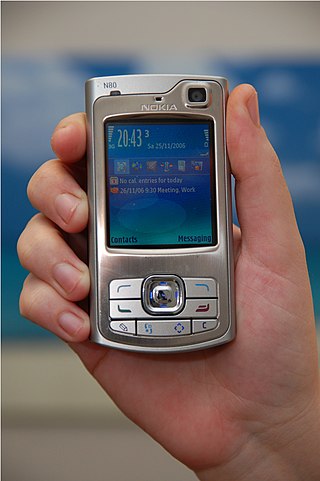
The Nokia N80 is a 3G smartphone from Nokia announced on November 2, 2005, part of the multimedia Nseries line. It runs on Symbian OS v9.1 and the S60 3rd Edition interface. It was first released in June 2006.

The Nokia N79 is a Symbian OS v9.3 smartphone and a member of the Nokia Nseries multimedia smartphone family running on S60 3rd Edition Feature Pack 2. It was officially announced by Nokia on 26 August 2008. The N79 is an advanced device with a 5 megapixel camera, dual LED flash, and GPS, with many improvements over the Nokia N78. It retailed for 350 euros upon release in October 2008.

The Nokia N81 is a Symbian OS smartphone announced by Nokia on 29 August 2007 and released the next month. It runs S60 3rd Edition, Feature Pack 1.
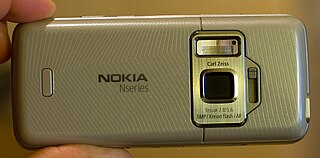
The Nokia N82 is a high-end smartphone produced by Nokia, and announced on 14 November 2007 as part of the company's Nseries line. The N82 runs Symbian OS v9.2. The N82 inherits much of the Nokia N95's features and specifications, with the major addition being its xenon flash. At the time the N82 was considered one of the most sophisticated camera phone on the market. It is also considered a successor to the Nokia N95, preceding the Nokia N96.

The Nokia E71 is a smartphone introduced in 8th May 2008 from the Eseries range with a QWERTY keyboard targeting business users worldwide. It runs on Symbian OS v9.2, with a Series 60 3rd Edition, second generation Feature Pack 1. The Nokia E71 succeeded the Nokia E61/61i models, building on the base design and form factor but enhancing on the feature set.
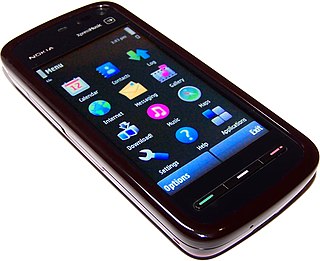
Nokia 5800 XpressMusic is a smartphone part of the XpressMusic line, announced by Nokia on 2 October 2008 in London and started shipping in November of that year. Code-named "Tube", it was the first touchscreen-equipped S60 device by Nokia – essentially it was the first device to run Symbian^1, also known as S60 5th Edition, the touch-specific S60-based platform created by the Symbian Foundation. The touchscreen features tactile feedback.

The Sony Ericsson Satio (U1) is a smartphone, announced by Sony Ericsson at the Mobile World Congress in Barcelona, Spain on 15 February 2009 as the Idou. It was released on 7 October 2009 in the UK in 3 colour schemes: Black, Silver and Bordeaux (Red).

The Nokia N86 8MP is a high-end smartphone with emphasis on the camera. It was announced on 17 February 2009 and released in May 2009 as part of the Nseries. It runs on Symbian OS 9.3 and shares similar design features with the N97. Its name references the camera's megapixel count.

The Nokia X6 is a music-oriented capacitive touchscreen smartphone and portable entertainment device by Nokia. It was announced in early September 2009 during Nokia World 2009 in Germany.

Symbian is a discontinued mobile operating system (OS) and computing platform designed for smartphones. It was originally developed as a proprietary software OS for personal digital assistants in 1998 by the Symbian Ltd. consortium. Symbian OS is a descendant of Psion's EPOC, and was released exclusively on ARM processors, although an unreleased x86 port existed. Symbian was used by many major mobile phone brands, like Samsung, Motorola, Sony Ericsson, and above all by Nokia. It was also prevalent in Japan by brands including Fujitsu, Sharp and Mitsubishi. As a pioneer that established the smartphone industry, it was the most popular smartphone OS on a worldwide average until the end of 2010, at a time when smartphones were in limited use, when it was overtaken by iOS and Android. It was notably less popular in North America.

The Nokia 5230 is a smartphone manufactured by Nokia, running Symbian OS v9.4, S60 5th Edition. It was released in November 2009 after being announced in August of the same year.

The Nokia C6-00 is a smartphone and portable entertainment handheld cellular device by Finnish communications company Nokia, running the Symbian S60v5 operating system. It was announced on April 13, 2010. It is the third Nokia Symbian^1 smartphone featuring a full slide-out QWERTY keyboard. Its software and hardware specifications resemble the N97 mini in most ways. One of the differences is that the sliding in this phone is flat, unlike the upward angled in the N97 mini, hence allowing a four row QWERTY keypad, bringing a slightly enhanced typing experience to the table. The phone has a 5-megapixel camera, though unlike the N97 mini, it does not have Carl Zeiss optics. It also has a secondary camera in front for video calls. The Nokia C6-01 is the successor to the C6-00 featuring a major step-up with the new Symbian^3 operating system, Ovi Maps 3.0 and such but losing the QWERTY keyboard.

The Nokia N8 is a touchscreen-based smartphone developed by Nokia. Announced on 27 April 2010, the Nokia N8 was the first device to run on the Symbian^3 mobile operating system and it was the company's flagship device for the year. It was released on 30 September 2010 at the Nokia Online Store before being released in markets around the world on 1 October 2010. There were two version made, the N8 and the N8-00. The N8 was made for Vodafone and locked to its networks, and the N8-00 was made by Microsoft and open network.
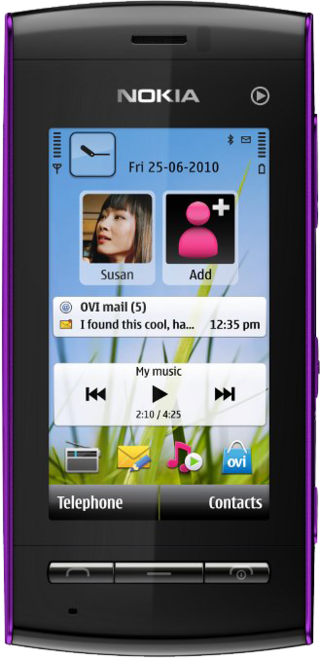
The Nokia 5250 is a budget Nokia resistive touchscreen smartphone running on Symbian v9.4 operating system with a S60 5th Edition user interface. Its price before tax and subsidies is €115. It was announced in August 2010. It was available in China, Eurasia, Europe, India, Latin America, Middle East, and South-East Asia and the Pacific Region. It is very small and compact. It comes preloaded with Guitar Hero Mobile series 5.
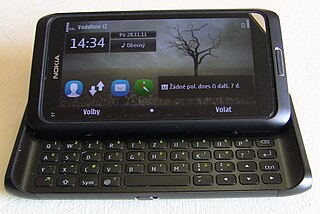
The Nokia E7-00, also known as Nokia E7, is a business-oriented QWERTY smartphone by Nokia from the Nokia Eseries. It was announced at Nokia World in September 2010 together with the Nokia C6-01 and Nokia C7 and started shipping in February 2011. It is the second phone after the Nokia N8 to be running the Symbian^3 operating system.

The Nokia Nseries was a high-end lineup of feature phones, smartphones, and tablets marketed by Nokia Corporation from 2005 to 2011. The Nseries devices commonly supported multiple high-speed wireless technologies at the time, such as 3G, or Wireless LAN. Digital multimedia services, such as music playback, photo/video capture or viewing, gaming or internet services were the central focus of the lineup. The lineup was replaced in 2011 by the Nokia Lumia line as the company's primary smartphone lineup.
Nokia's strategic nomenclature can be traced back in 2005 when the Nseries line was launched, offering devices with flagship specifications and premium hardware at various price points. These devices were considered the "bread and butter" of the company and were often positioned to showcase their latest technologies. Thanks to the newfound consumer and enterprise interest in smartphones at the time, the company introduced four additional collections to diversify their product portfolio and meet demands in most market segments. These new phone series were named Eseries, targeting small business and enterprise customers; Xseries, providing consumer-grade multimedia-focused devices; Cseries, which Nokia used to target both the low-end and mid-range market segments; and Tseries, for devices exclusive to the Chinese market.



















